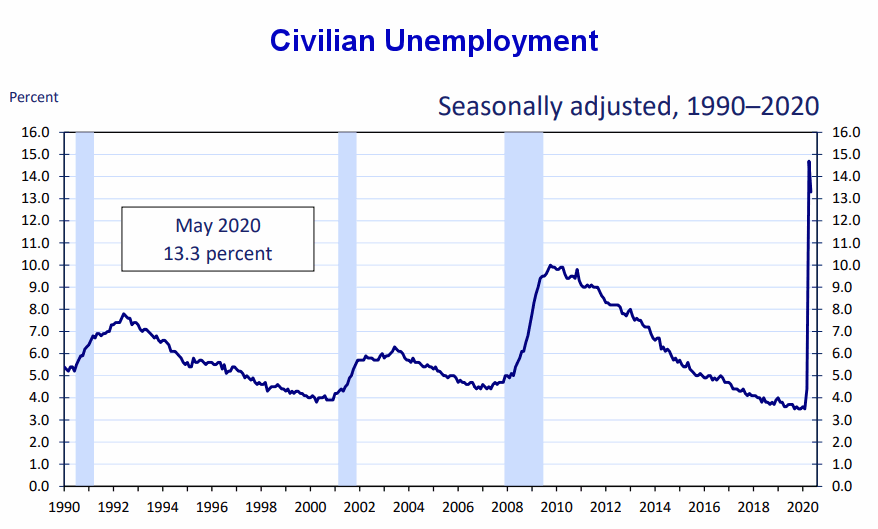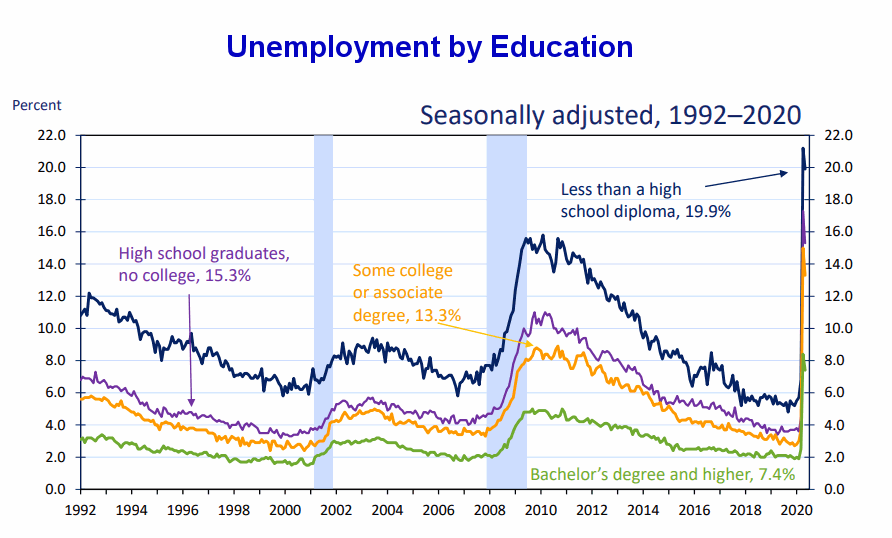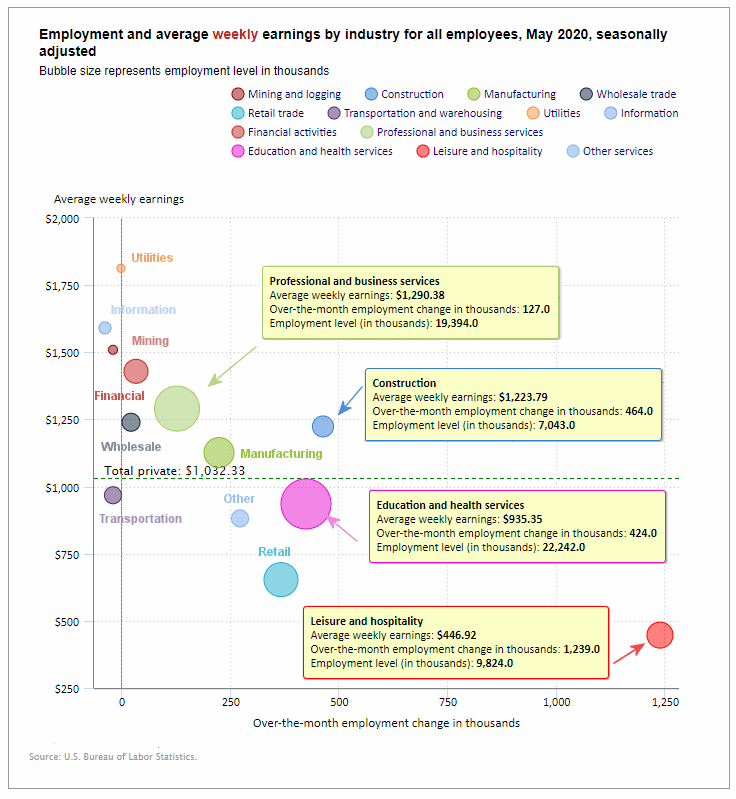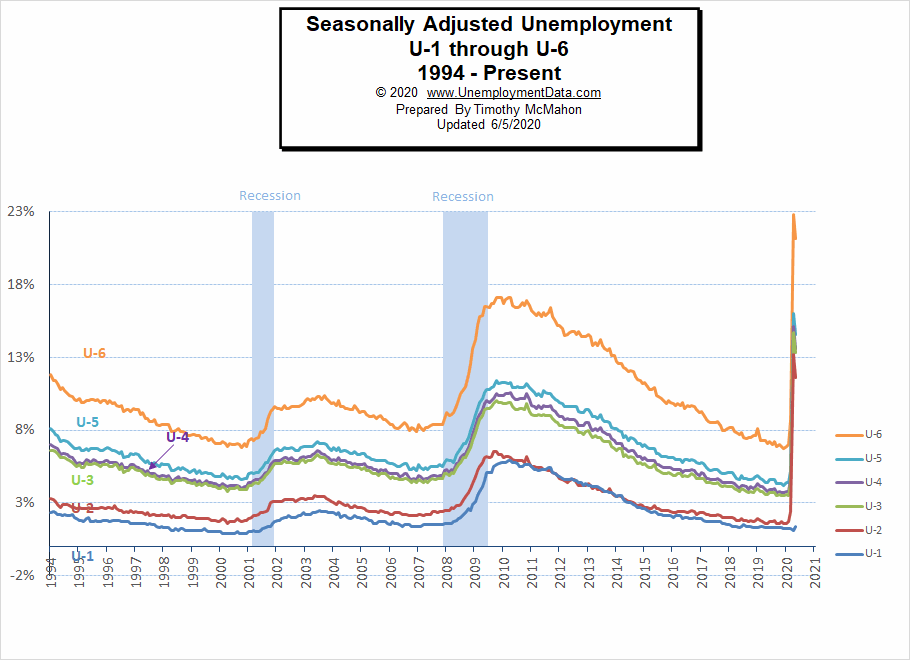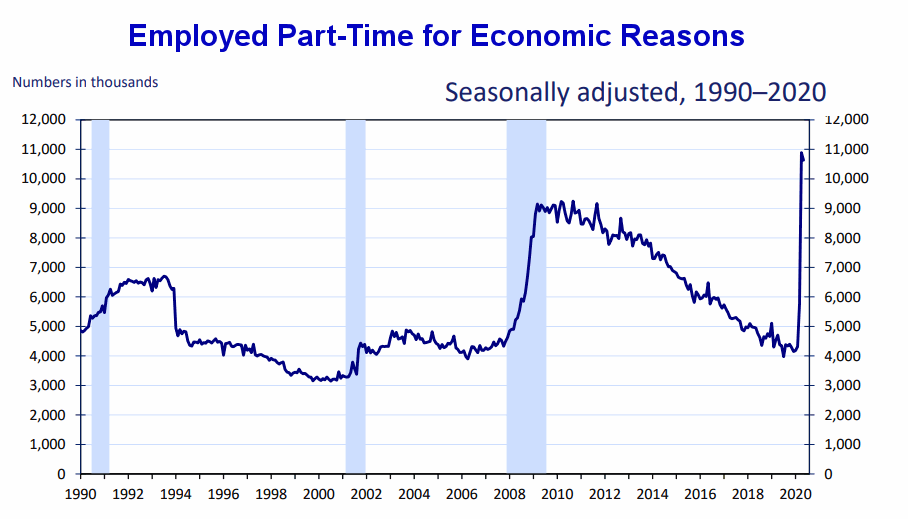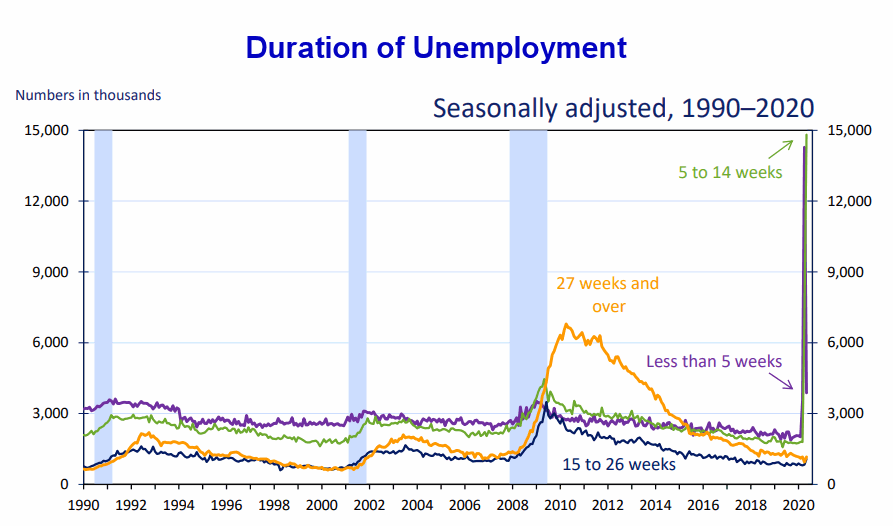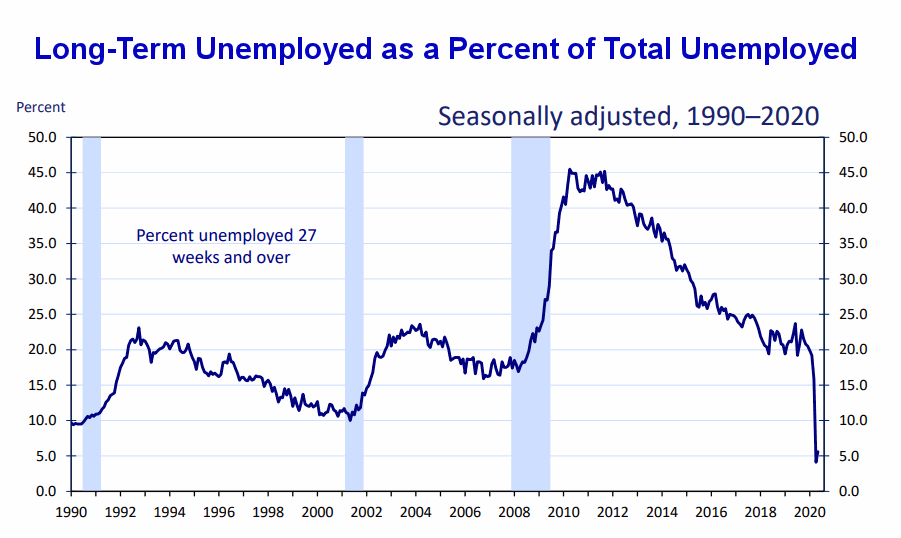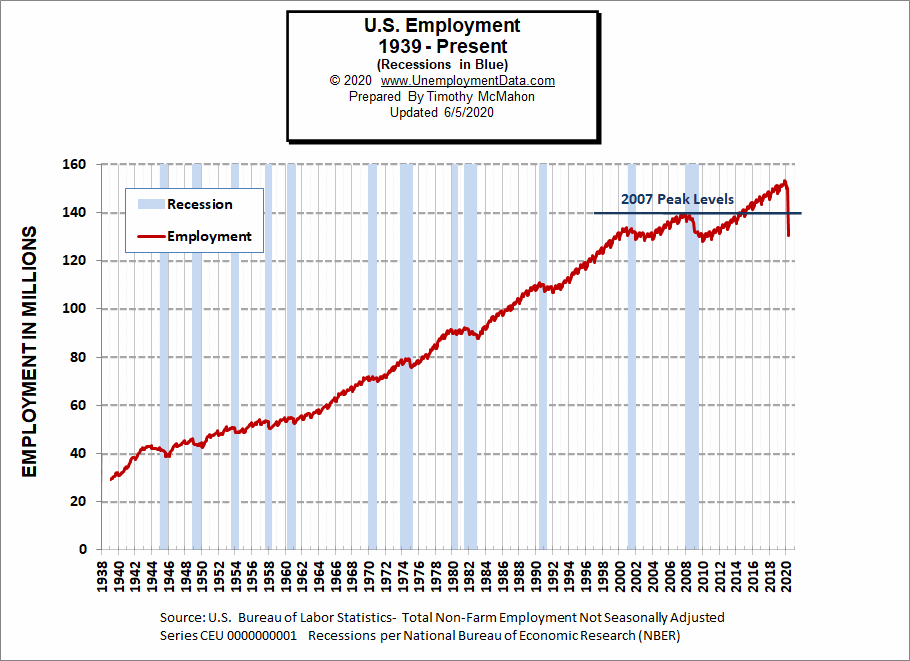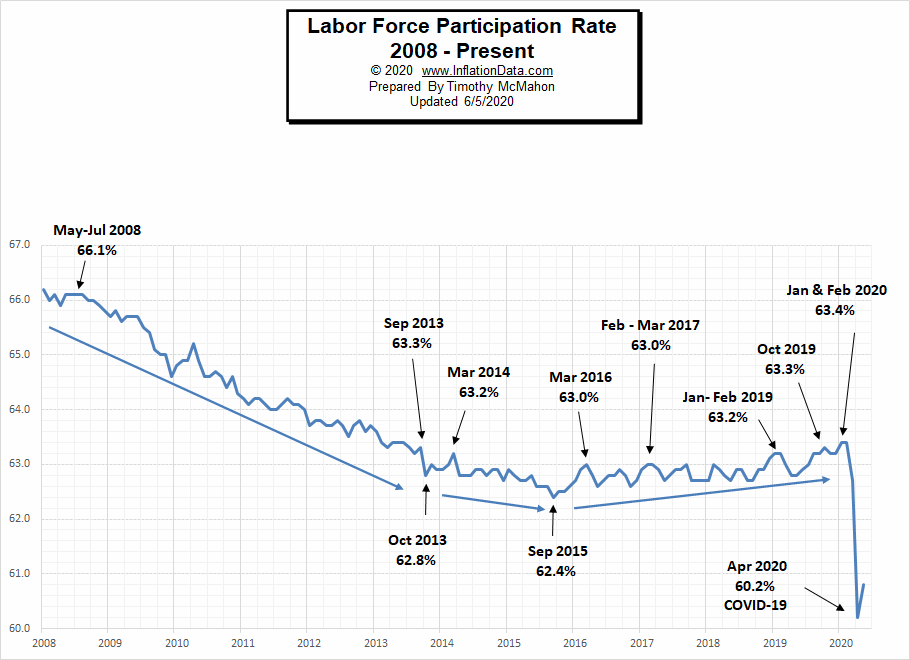![]()
The U.S. Bureau of Labor Statistics (BLS) released its employment / unemployment report for May on June 5th.
COVID-19 Unemployment Decreases as People Return to Work
- Unadjusted U-3 was Down from 14.4% to 13.0%.
- Adjusted U-3 was Down from 14.7% to 13.3%.
- Unadjusted U-6 was Down from 22.4% to 20.7%.
- Labor Force Participation rose from 60.2% to 60.8%.
- Unadjusted Employment rose by approx. 2.9 million jobs.
Civilian Unemployment
Economists were predicting another stairstep increase in unemployment in May. According to a CNBC article “Economists surveyed by Dow Jones had been expecting payrolls to drop by 8.33 million and the unemployment rate to rise to 19.5% from April’s 14.7%.”
Instead, Unemployment fell to 13.3% and payrolls rose by 2.9 million making the “experts” wrong by roughly 11 million.
According to the Commissioner of the U.S. Bureau of Labor Statistics:
“Nonfarm payroll employment increased by 2.5 million in May, and the unemployment rate declined by 1.4 percentage points to 13.3 percent. These improvements in the labor market reflected a limited resumption of economic activity that had been curtailed in March and April due to the coronavirus (COVID-19) pandemic and efforts to contain it.
In May, employment rose in several major industry sectors, with the largest gains in leisure and hospitality, construction, education and health services, and retail trade. By contrast, employment in government continued to decline sharply.”
Of course, he is talking about “Seasonally Adjusted Jobs” from the “Current Population Survey (CPS)”
rather than looking at the results reported by actual companies in their “Current Employment Statistics survey (CES)”
But looking at the CES report we see…
Originally the BLS reported 131.071 million jobs for April and then they subtracted 660,000 jobs from that estimate.
So currently they are saying 130.411 million jobs for April and 133.342 million jobs for May which is actually an increase of 2.271 million jobs compared to what they originally reported last month. Or 2.931 million jobs based on their current estimates of April’s employment.
Unemployment by Education
Those unemployed with less than a Hih School Diploma fell from 21.2% in April to 19.9% in May while at the opposite end of the spectrum those with a Bachelor’s degree or higher fell from 8.4% to 7.4%.
Typically those with a Bachelor’s degree are relatively immune to unemployment. Although during the 2008 recession college grads unemployment rose to slightly above 4%.
Current Employment
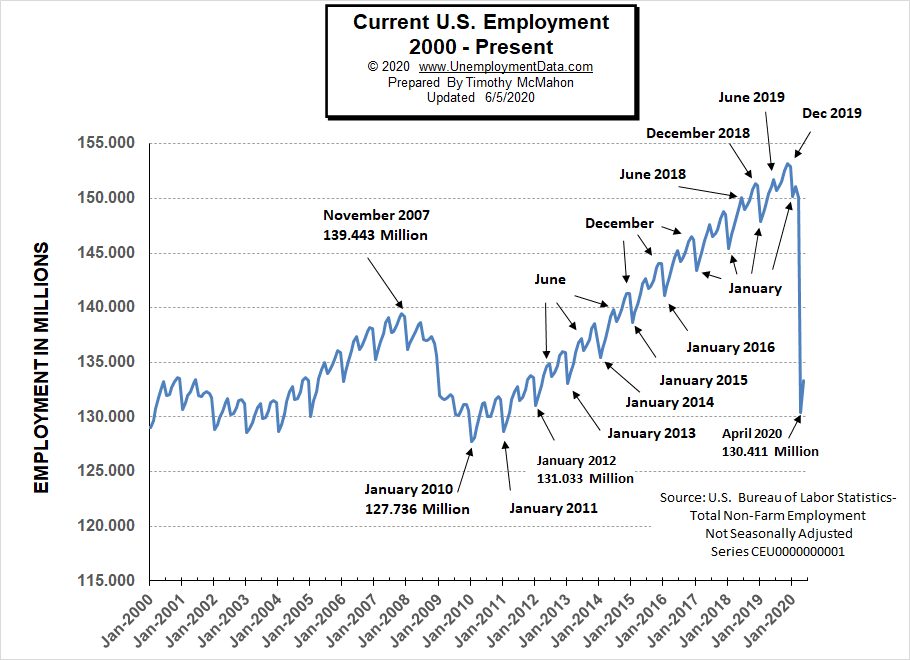
Employment by Sector
The employment “bubble chart” gives us a good representation of how each sector of the economy is doing (employment wise on a seasonally adjusted basis). Last month we had the worst looking sector chart ever. Not a single sector had a gain (i.e. all sectors are to the left of the zero line). This month only 4 sectors remain below the zero line. They were Transportation, Information, Utilities, and Mining.
Leisure and Hospitality gained 1,239,000 jobs although they had lost over -7 million jobs the month before. Retail gained 367,800 after losing roughly -2 million jobs in April.
Transportation lost -19,000 employees. Mining and logging lost another -20,000 employees on top of last month’s -50,000 employees, and Wholesale gained back 21,400 of their lost -362,800 employees.
Professional and business services gained 127,000, Education and Health gained 424,000 while other services gained 272,000.
Average weekly wages actually rose to $1.32.33 in May from $1,026.34 in April.
(See the table below for details.)
How to read this chart:
Bubbles location on the chart tell us two things:
- Change in Employment Levels over the most recent month.
- Average Weekly earnings.
- The further to the right the bubble the larger the increase in the number of jobs.
- The higher up on the chart the larger the average salary.
Bubble Size tells us:
- Total Employment for the sector.
- Larger bubbles mean more people are employed in that sector.
Employment and Average Weekly Earnings by Industry
May 2020, Seasonally Adjusted
| Industry | Monthly Increase | Average Weekly Earnings | Employment Level |
| Total Private Employment | 3,094,000 | $1,032.33 | 111,732,000 |
| Mining and Logging | -20,000 | $1,509.30 | 632,000 |
| Construction | 464,000 | $1,223.79 | 7,043,000 |
| Manufacturing | 225,000 | $1,126.54 | 11,707,000 |
| Wholesale trade | 21,400 | $1,239.56 | 5,561,100 |
| Retail trade | 367,800 | $653.54 | 13,668,600 |
| Transportation and Warehousing | -19,000 | $967.76 | 5,095,900 |
| Utilities | -2,300 | $1,812.49 | 540,000 |
| Information | -33,000 | $1,590.64 | 2,578,000 |
| Financial Activities | 33,000 | $1,429.22 | 8,596,000 |
| Professional and Business Services | 127,000 | $1,290.38 | 19,394,000 |
| Education and Health Services | 424,000 | $935.35 | 22,242,000 |
| Leisure and Hospitality | 1,239,000 | $446.92 | 9,824,000 |
| Other Services | 272,000 | $881.27 | 4,850,000 |
U1 through U6 Unemployment Rates
Last month all the various measurements of Seasonally Adjusted Unemployment from U-1 through U-6 spiked up sharply except U1 which measures unemployment over 15 weeks. This month we saw a decline in all of them except U1 as expected. For more information about the various measurements of unemployment see What Is U-6 Unemployment?
Employed Part-Time for Economic Reasons
Last month, in addition to those who lost their jobs outright many were forced to work part-time although they would rather work full-time. In May that number decreased slightly.
Source: Bureau of Labor Statistics
Duration of Unemployment
Although it is difficult to see in this chart those unemployed for “Less than 5 weeks” fell sharply meaning that newly laid-off people are declining indicating that things aren’t getting worse. Most of the unemployed have been so for from 5 to 14 weeks with very few in the 15 to 26 weeks or over 27-week category.
The one “dark cloud” this month is in the ranks of the long-term unemployed. We see a slight uptick in those unemployed over 27 weeks. Hopefully, the country will get back on track and the unemployment levels will drop so those long-term unemployed people can get back to work.
Data Source: BLS Labor Productivity
Reasons for Unemployment
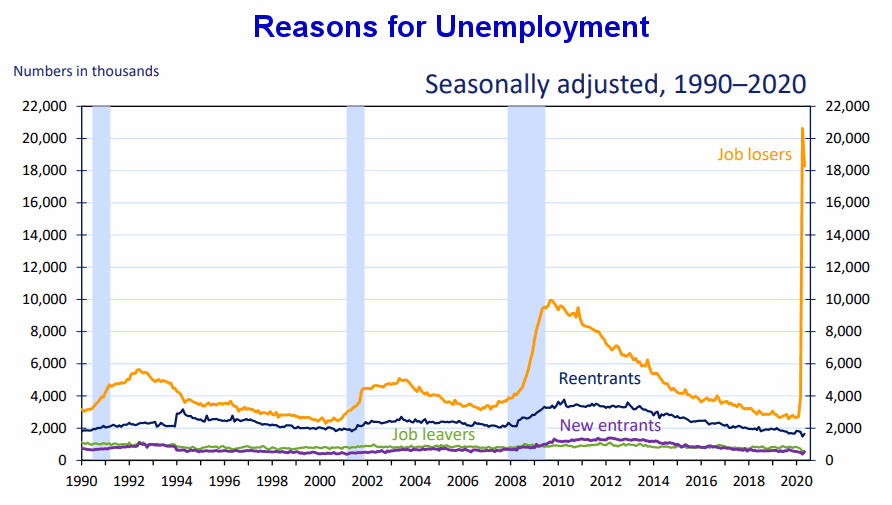
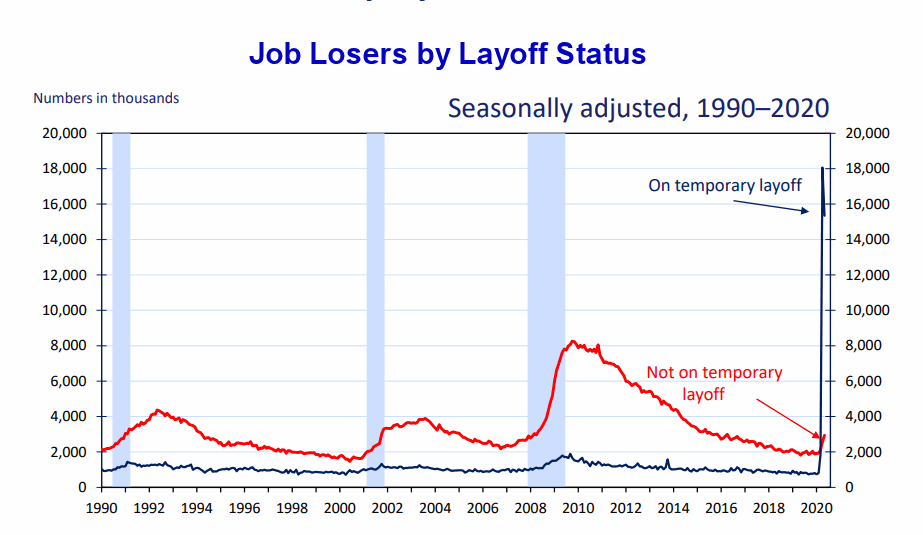
This chart has a hint of good news in that the majority of the job losses are “temporary”. However, if we look closely we can also see an upturn in the “not temporary” category. We can also see a drop in the temporary category as some workers are returning to their jobs.

Previous Record Low Unemployment (Seasonally Adjusted U-3)
If we consider anything 4% or below as “low” we have had a few “low” stretches as we can see in the table below.
(4% or below in Green)
| Jan | Feb | Mar | Apr | May | Jun | Jul | Aug | Sep | Oct | Nov | Dec | |
| 1950 | 6.5% | 6.4% | 6.3% | 5.8% | 5.5% | 5.4% | 5.0% | 4.5% | 4.4% | 4.2% | 4.2% | 4.3% |
| 1951 | 3.7% | 3.4% | 3.4% | 3.1% | 3.0% | 3.2% | 3.1% | 3.1% | 3.3% | 3.5% | 3.5% | 3.1% |
| 1952 | 3.2% | 3.1% | 2.9% | 2.9% | 3.0% | 3.0% | 3.2% | 3.4% | 3.1% | 3.0% | 2.8% | 2.7% |
| 1953 | 2.9% | 2.6% | 2.6% | 2.7% | 2.5% | 2.5% | 2.6% | 2.7% | 2.9% | 3.1% | 3.5% | 4.5% |
| 1954 | 4.9% | 5.2% | 5.7% | 5.9% | 5.9% | 5.6% | 5.8% | 6.0% | 6.1% | 5.7% | 5.3% | 5.0% |
| 1955 | 4.9% | 4.7% | 4.6% | 4.7% | 4.3% | 4.2% | 4.0% | 4.2% | 4.1% | 4.3% | 4.2% | 4.2% |
| 1956 | 4.0% | 3.9% | 4.2% | 4.0% | 4.3% | 4.3% | 4.4% | 4.1% | 3.9% | 3.9% | 4.3% | 4.2% |
| 1957 | 4.2% | 3.9% | 3.7% | 3.9% | 4.1% | 4.3% | 4.2% | 4.1% | 4.4% | 4.5% | 5.1% | 5.2% |
| 1958 | 5.8% | 6.4% | 6.7% | 7.4% | 7.4% | 7.3% | 7.5% | 7.4% | 7.1% | 6.7% | 6.2% | 6.2% |
| … | … | … | … | … | … | … | … | … | … | … | … | … |
| 1965 | 4.9% | 5.1% | 4.7% | 4.8% | 4.6% | 4.6% | 4.4% | 4.4% | 4.3% | 4.2% | 4.1% | 4.0% |
| 1966 | 4.0% | 3.8% | 3.8% | 3.8% | 3.9% | 3.8% | 3.8% | 3.8% | 3.7% | 3.7% | 3.6% | 3.8% |
| 1967 | 3.9% | 3.8% | 3.8% | 3.8% | 3.8% | 3.9% | 3.8% | 3.8% | 3.8% | 4.0% | 3.9% | 3.8% |
| 1968 | 3.7% | 3.8% | 3.7% | 3.5% | 3.5% | 3.7% | 3.7% | 3.5% | 3.4% | 3.4% | 3.4% | 3.4% |
| 1969 | 3.4% | 3.4% | 3.4% | 3.4% | 3.4% | 3.5% | 3.5% | 3.5% | 3.7% | 3.7% | 3.5% | 3.5% |
| 1970 | 3.9% | 4.2% | 4.4% | 4.6% | 4.8% | 4.9% | 5.0% | 5.1% | 5.4% | 5.5% | 5.9% | 6.1% |
| … | … | … | … | … | … | … | … | … | … | … | … | … |
| 1999 | 4.3% | 4.4% | 4.2% | 4.3% | 4.2% | 4.3% | 4.3% | 4.2% | 4.2% | 4.1% | 4.1% | 4.0% |
| 2000 | 4.0% | 4.1% | 4.0% | 3.8% | 4.0% | 4.0% | 4.0% | 4.1% | 3.9% | 3.9% | 3.9% | 3.9% |
| 2001 | 4.2% | 4.2% | 4.3% | 4.4% | 4.3% | 4.5% | 4.6% | 4.9% | 5.0% | 5.3% | 5.5% | 5.7% |
| … | … | … | … | … | … | … | … | … | … | … | … | … |
| 2018 | 4.1% | 4.1% | 4.1% | 3.9% | 3.8% | 4.0% | 3.9% | 3.9% | 3.7% | 3.7% | 3.7% | 3.9% |
| 2019 | 4.0% | 3.8% | 3.8% | 3.6% | 3.6% | 3.7% | 3.7% | 3.7% | 3.5% | 3.6% | 3.5% | 3.5% |
| 2020 | 3.6% | 3.5% | 4.4% | 14.7% | 13.3% |
Employment
Historically employment is closely tied to recessions and that is no accident. One of the primary factors in calculating whether the economy is officially in a recession is an increase in the unemployment rate. The chart below provides the Historical Employment Data overlaid on blue bars showing periods of official recessions. We can see that the number of people employed has fallen below the 2007 peak and is nearing the lows of the 2008-2010 crash. What we can’t see on this chart is the rebound this month.
See Historical Employment Data for more info.
Current Employment
From the above current employment chart, we can see this month’s rebound and note that it still has a long way to go. We can also see that the low point for each year occurs in January and then a small peak occurs around June with a slight drop around July and then the highest peak in employment happens in November/December. But the drop in March-April was unprecedented taking the number of employed down very close to the lows of January 2012.
See Current Employment for more info.
Labor Force Participation Rate
The Labor Force Participation Rate for April 2020 fell sharply breaking the slight upward trend that had been in place since October 2015.
See Labor Force Participation Rate for more information.
If you would like to receive this monthly report and other article updates click here you can unsubscribe at any time.
Here are some articles you might enjoy in case you missed them:
Read more on UnemploymentData.com.
- Unemployment Rate by State April 2020
- Why Woodworking and Manual Trades Are Still in Demand in 2020
- Coronavirus Shutdown Causes 20 Million Job Losses
- 4 Industries That Are Urgently Hiring Essential Workers
- 7 Reasons to Consider a Career in Data Analytics
From InflationData.com
- Why Inflation Affects Various Individuals Differently
- April Inflation Near Zero
- What Causes Inflation? Rising Prices Explained
- The 2008 Financial Crisis
- What are Central Banks?
- March Inflation Crashes
- Inflation Expectations and the Massive Fed Stimulus
- What is the Federal Funds Rate?
From Financial Trend Forecaster
- Oil Goes from Zero to $35 in a Month, But is it Enough?
- Top 5 Reasons Why 5G Will Change the Finance Industry
- How Can Oil Be Worth Less than Nothing?
- Saudi Arabia’s Oil Price War Is Backfiring
- Electricity Rates by State
- Emerging Markets and Epidemics
- Deflationary Psychology Versus the Fed: Here’s the Likely Winner
- Crude Oil’s 2020 Crash: See What Helped (Some) Traders Pivot Just in Time
- Stocks: Is the Worst Over or is there Worse Yet to Come?
- Junk Bonds: 2 “Golden” Junctures
From OptioMoney.com
- Learning to Trade from Video Tutorials
- How Saxo Bank Democratizes Trading and Investment
- Five Business Tips to Help Your Company Thrive
- Have Minimal Car Insurance? What to Do in Case of an Accident
- How to Choose a Residential Roofing Contractor
From Your Family Finances

